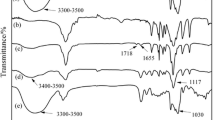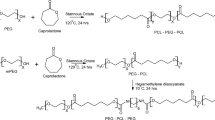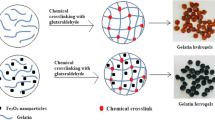Abstract
This paper deals with the synthesis of thermo-responsive microspheres with proteic structure exhibiting a transition temperature close to the body temperature. Temperature-sensitive hydrogels have attracted extensive interest due to their potential and promising applications in drug delivery field since they can undergo a rapid and reversible phase transition from a swollen to a shrunken state depending on environmental temperature. The hydrogels were synthesized by free-radical polymerization of hydrolyzed methacrylated gelatin (HGel-MA) and N,N′-methylenebisacrylamide as pro-hydrophilic multifunctional macromer and crosslinker, respectively, and N-isopropylacrylamide as thermo-responsive monomer. Thermal analyses showed negative thermo-responsive behavior for all compositions and, by increasing the content of the hydrophilic moieties in the network, the transition temperature raised to 36.9°C, close to the physiological values. In order to test the materials as drug carriers, diclofenac sodium salt was chosen as model drug. Drug release profiles, in phosphate buffer solution (pH 7.0, 10−3 M) at 25 and 40°C, depend on the hydrogel’s crosslinking degree and hydrophilic/hydrophobic balance in the polymeric network. For all formulations, in the shrunken state, the drug release percent values ranged from 80% to 100% after 24 h, and after 3 h, more than 60% of therapeutics was delivered. On the contrary, the swelling of the loaded microparticles produces, even after 30 h, a drug release percent of about 75%. By using semi-empirical equations, the release mechanism was extensively studied and the diffusional contribute was evaluated. The physico-chemical characteristics of thermo-responsive materials confirm the applicability of the microspheres as drug delivery device.







Similar content being viewed by others
References
Peppas NA, Bures P, Leobandung W, Ichikawa H. Hydrogels in pharmaceutical formulations. Eur J Pharm Biopharm. 2000;50:27–46.
Anderson DG, Burdick JA, Langer R. Smart biomaterials. Science. 2004;305:1923–4.
Lang Y, Jiang T, Li S, Zheng L. Study on physicochemical properties of thermosensitive hydrogels constructed using graft-copolymers of poly(N-isopropylacrylamide) and guar gum. J Appl Polym Sci. 2008;108:3473–9.
Langer R, Tirrell DA. Designing materials for biology and medicine. Nature. 2004;428:487–92.
Bawa P, Pillay V, Choonara YE, Du Toit LC. Stimuli-responsive polymers and their applications in drug delivery. Biomed Mater. 2009. doi:10.1088/1748-6041/4/2/022001.
De Las Heras Alarcón C, Pennadam S, Alexander C. Stimuli responsive polymers for biomedical applications. Chem Soc Rev. 2005;34:276–85.
Peppas NA, Leobandung W. Stimuli-sensitive hydrogels: ideal carriers for chronobiology and chronotherapy. J Biomater Sci Polym Ed. 2004;15:125–44.
Iemma F, Spizzirri UG, Puoci F, Muzzalupo R, Trombino S, Cassano R et al. pH-Sensitive hydrogels based on bovine serum albumin for oral drug delivery. Int J Pharm. 2006;312:151–7.
Qiu Y, Park K. Environment-sensitive hydrogels for drug delivery. Adv Drug Deliver Rev. 2001;53:321–39.
Dimitrov I, Trzebicka B, Müller AHE, Dworak A, Tsvetanov CB. Thermosensitive water-soluble copolymers with doubly responsive reversibly interacting entities. Progr Polym Sci. 2007;32:1275–343.
Bikram M, West JL. Thermo-responsive systems for controlled drug delivery. Exp Opin Drug Deliv. 2008;5:1077–91.
Iemma F, Spizzirri UG, Puoci F, Cirillo G, Curcio M, Parisi OI et al. Synthesis and release profile analysis of thermo-sensitive albumin hydrogels. Colloid Polym Sci. 2009;287:779–87.
Klouda L, Mikos AG. Thermoresponsive hydrogels in biomedical applications. Eur J Pharm Biopharm. 2008;68:34–45.
Pan C, Long Q, Yu D, Rao Y, Wu N, Li X. Swelling and drug releasing properties of poly(N-isopropylacrylamide) thermo-sensitive copolymer gels. Front Chem China. 2008;3:314–9.
Chang Y, Xiao L, Tang Q. Preparation and characterization of a novel thermosensitive hydrogel based on chitosan and gelatin blends. J Appl Polym Sci. 2009;113:400–7.
Joly-Duhamel C, Hellio D, Djabourov M. All gelatin networks: 1. Biodiversity and physical chemistry. Langmuir. 2002;18:7208–17.
Yang H, Kao WJ. Thermoresponsive gelatin/monomethoxy poly(ethylene glycol)-poly(D, L-lactide) hydrogels: formulation, characterization, and antibacterial drug delivery. Pharm Res. 2006;23:205–14.
Chun S, Kim J. A novel hydrogel-dispersed composite membrane of poly(N-isopropylacrylamide) in a gelatin matrix and its thermally actuated permeation of 4-acetamidophen. J Control Release. 1996;38:39–47.
Lee W, Lee S. Effect of gelatin on the drug release behaviors for the organic hybrid gels based on N-isopropylacrylamide and gelatine. J Mater Sci Mater Med. 2007;18:1089–96.
Ritger PL, Peppas NA. A simple equation for description of solute release I. Fickian and non-Fickian release from non-swellable devices in the form of slabs, spheres, cylinders or discs. J Control Release. 1987;5:23–36.
Peppas NA, Sahlin JJ. A simple equation for the description of solute release. III. Coupling of diffusion and relaxation. Int J Pharm. 1989;57:169–72.
Lin LH, Chen KM. Preparation and surface modification of gelatine derivative surfactants. Colloid Surf A. 2006;272:8–14.
Iemma F, Spizzirri UG, Muzzalupo R, Puoci F, Trombino S, Picci N. Spherical hydrophilic microparticles by radical copolymerization of functionalized bovine serum albumin. Coll Polym Sci. 2004;283:250–6.
Malliou ET, Markopoulou CK, Koundourellis JE. Simultaneous determination of clobutinol together with some anti-inflammatory drugs in urine by HPLC. J Liq Chromatogr Relat Technol. 2004;27:1565–77.
Cirillo G, Iemma F, Puoci F, Parisi OI, Curcio M, Spizzirri UG et al. Imprinted hydrophilic nanospheres as drug delivery system for 5-fluorouracil sustained release. J Drug Target. 2009;17:72–7.
Kriwet B, Walter E, Kissel T. Synthesis of bioadhesive poly(acrylic acid) nano- and microparticles using an inverse emulsion polymerization method for the entrapment of hydrophilic drug candidates. J Control Release. 1998;56:149–58.
Schmaljohann D. Thermo- and pH-responsive polymers in drug delivery. Adv Drug Deliv Rev. 2006;58:1655–70.
Zhao C, Zhuang X, He P, Xiao C, He C, Sun J et al. Synthesis of biodegradable thermo- and pH-responsive hydrogels for controlled drug release. Polymer. 2009;50:4308–16.
Spizzirri UG, Iemma F, Puoci F, Xue F, Gao W, Cirillo G et al. Synthesis of hydrophilic microspheres with LCST close to body temperature for controlled dual-sensitive drug release. Polym Adv Technol. 2010. doi:10.1002/pat.1660.
Mathews AS, Cho W-J, Kim I, Ha C-S. Thermally responsive poly[N-isopropylacrylamide-co-2-hydroxyethylacrylate] colloidal crystals included in β-cyclodextrin for controlled drug delivery. J Appl Polym Sci. 2009;113:1680–9.
Shi J, Liu L, Liu X, Sun X, Cao S. Inorganic–organic hybrid alginate beads with LCST near human body temperature for sustained dual-sensitive drug delivery. Polym Adv Technol. 2008;19:1467–73.
Zhang X-Z, Chu C-C. Temperature-sensitive poly(N-isopropylacrylamide)/poly(ethylene glycol) diacrylate hydrogel microspheres: formulation and controlled drug release. Am J Drug Deliv. 2005;3:55–65.
Acknowledgments
This work was financially supported by MIUR (Programma di ricerca di rilevante interesse nazionale 2008) and University of Calabria funds.
Author information
Authors and Affiliations
Corresponding author
Rights and permissions
About this article
Cite this article
Curcio, M., Puoci, F., Spizzirri, U.G. et al. Negative Thermo-responsive Microspheres Based on Hydrolyzed Gelatin as Drug Delivery Device. AAPS PharmSciTech 11, 652–662 (2010). https://doi.org/10.1208/s12249-010-9429-5
Received:
Accepted:
Published:
Issue Date:
DOI: https://doi.org/10.1208/s12249-010-9429-5




